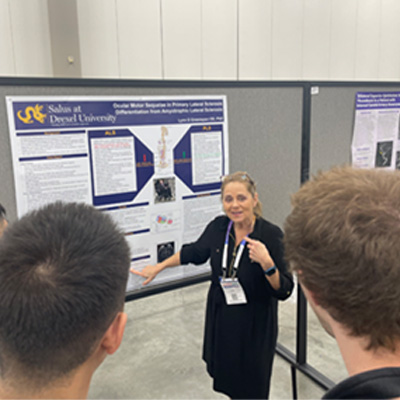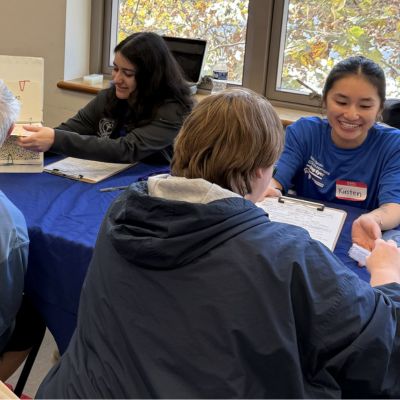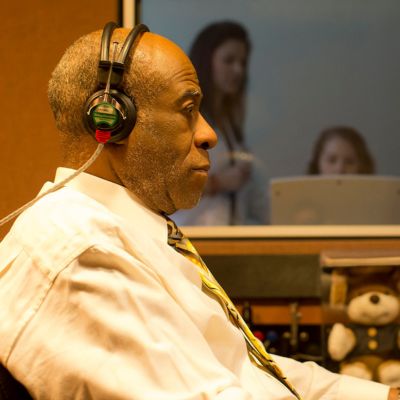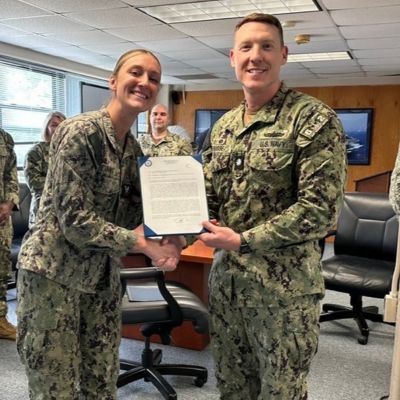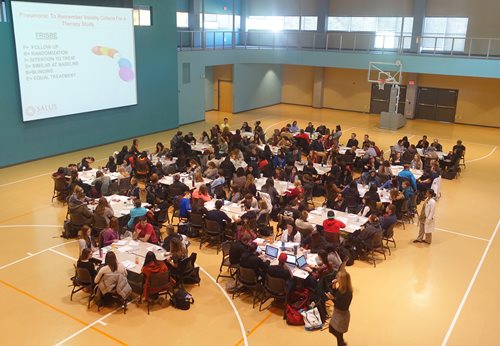
One of the core values of this institution is and has always been sharing knowledge in a learning environment. In addition to being patient-centric, the Salus DNA contains a deeply-rooted belief that it is important that all professions represented within a healthcare team recognize the advantages and opportunities to work together for the optimum benefit of each patient.
In today’s healthcare world, interprofessional education (IPE) is essential. “As the landscape of American healthcare evolves from a culture of intervention to prevention it also requires an integrated approach that pivots around primary care,” says President Mittelman. “This evolution is driven by the Affordable Care Act, as well as the fact that Americans are confronted with chronic diseases such as obesity, diabetes, hypertension and other associated disorders.”
“As healthcare is delivered in a more integrated fashion,” he continues, “it’s imperative that our students understand - and more importantly excel at - working within a multi-disciplinary, interprofessional environment. The foundation for all programs we offer at Salus is based on this premise.”
What may sound like lip service at other institutions is anything but here in Elkins Park, where the commitment to teach students about the world of IPE runs deep.
IPE Past
Pennsylvania College of Optometry operated an external low vision rehabilitation clinic in the Low Vision Center for the Blind in West Philadelphia in the mid-seventies. Here PCO optometrists and students, social workers and low vision specialists worked together. In 1978 the William Feinbloom Center for Low Vision Rehabilitation opened at The (brand new) Eye Institute (TEI). The Eye Institute was hailed as the first optometric care facility in the nation to embrace a multidisciplinary approach involving optometrists, ophthalmologists, physicians, low vision rehabilitation specialists, students and other healthcare professionals working together to provide vision and eye care.
Dr. Feinbloom’s renown in the field of low vision drew patients from around the world. In 1978, Feinbloom director Randy Jose, OD hired low vision rehabilitation specialists Audrey Smith, PhD and Duane Geruschat, PhD, MSc to work full-time with Richard Brilliant, OD, who had completed a one-year residency under Dr. Jose and was into the second year of a two-year residency under Dr. Feinbloom.
Employing Drs. Smith and Geruschat was groundbreaking at the time, as “hiring blindness and low vision people to work in an eye clinic wasn’t exactly linear thinking,” according to Dr. Geruschat, now a Salus associate professor. Dr. Brilliant, who was chief at Feinbloom from 1979 to 1989, recalls the multi-disciplinary approach at Feinbloom during the end of day meetings. The needs of each patient seen that daywere discussed by the group. “If someone mentioned follow up for activities for daily living, we brought in a rehabilitation person,” he says. “If we needed a certain specialist, we contacted one.”
With optometrists, low vision professionals and social workers now working together at Feinbloom, the interprofessional/interdisciplinary journey of PCO began in earnest. Optometry students would spend part of their clinical training in Feinbloom learning low vision rehabilitation. Dr. Geruschat recalls an atmosphere that was “incredibly stimulating and special,” as everyone worked and learned together, a recollection echoed by Drs. Brilliant and Smith.
A six-week low vision rehabilitation course developed by Drs. Jose and Smith paved the way for the first non-optometric degree in PCO’s history. In 1983 the College petitioned the Commonwealth’s Department of Education to offer a Master of Science degree program in vision rehabilitation. This approval signaled the beginning of PCO as a multi-purpose institution and PCO’s Graduate Studies in Blindness and Low Vision was established.
It was at Feinbloom that the natural interdisciplinary component of the low vision and blindness profession shone. As opposed to many optometrists and healthcare providers at that time, low vision and blindness professionals took interprofessional education and consultation as a given, working as they did in concert with speech-language, occupational and physical therapists, social workers, dentists, doctors, and nurses in order to coordinate individual care plans and goal setting for their clients.
With the addition of the audiology and physician assistant programs in 2000 and 2007 respectively, PCO and then Salus made interprofessional classes part of the curriculum in 2007 with an Evidence-Based Medicine (EBM) class. Initially taught jointly by audiology faculty member, Radhika Aravamudhan, PhD, and PCO faculty member Derek Mladenovich, OD, MPH, the EBM course was required for the first semester of the first term for all optometry, audiology and physician assistant students. In the second year of the program, Melissa Vitek, OD replaced Dr. Mladenovich. Today Dr. Aravamudhan and Dr. Vitek co-teach Evidence-Based Practice (EBP), the revised course name.
Those early classes were training for faculty as well as students. The faculty met with one another frequently on an IPE basis, according to Dr. Aravamudhan and it was productive. The natural tendency of students to stay in their own groups of optometry, audiology and physician assistant was tested in the EBM classes says Dr. Vitek. Mixed groups of students from all three programs were created for assignments and projects but a residual “silo effect” persisted. There was a need to construct activities so that all students participated. The two instructors tweaked and changed the physical set up, making it more conducive to student participation.
IPE Present
Based on student and faculty feedback from those early EBM classes, in 2012 the institutional decision was made to explore options to provide more extensive IPE opportunities for students in all programs.. The University interprofessional education committee - with representatives from all programs - was formed. According to Dr. Linda Casser, committee chair and the University’s coordinator of interprofessional education initiatives, one of the most rewarding aspects of IPE, has been “how much we (the faculty) needed this initiative to get to know one another and what we each do. The big ‘wow’ has been in the process of each IPE project, not just the outcome. Personally, it’s been a great experience to go beyond my own profession.”
By now Drs. Vitek and Aravamudhan were more convinced that the delivery of the EBP program needed to change, particularly as second-year occupational therapy students were now in attendance. With backing from the University in the form of further team-based learning workshops and education, the two began to tweak the program. Dr. Vitek speaks of the flipped class learning* and inductive teaching** methods now used in the EBP class. Both instructors have had to learn the best way to “flip and not flop” in the class, says Dr. Aravamudhan. Mixed results in the beginning have led to revisions and tweaks that have garnered positive feedback. More importantly, students are learning about interacting with other professions from the beginning of their Salus education.
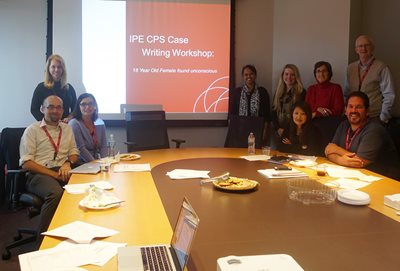 In the spring of 2014, an IPE pilot for the existing Clinical Problem Solving (CPS) course began. As Dr. Casser explains, “CPS was the most flexible arena in which to explore IPE more fully,” a statement echoed by her colleagues. CPS classes are held with small groups of optometry, audiology or physician assistant students and a faculty facilitator. They are specifically designed to build students’ clinical reasoning through a problem-based or case-based learning approach.
In the spring of 2014, an IPE pilot for the existing Clinical Problem Solving (CPS) course began. As Dr. Casser explains, “CPS was the most flexible arena in which to explore IPE more fully,” a statement echoed by her colleagues. CPS classes are held with small groups of optometry, audiology or physician assistant students and a faculty facilitator. They are specifically designed to build students’ clinical reasoning through a problem-based or case-based learning approach.
The IPE CPS pilot began in fall 2014 and the volunteer student participants were able to take the pilot class in lieu of one of their cohort CPS classes. Dr. Thomas Lewis, the main IPE CPS facilitator, had been approached by Provost Janice Scharre during the summer about the pilot idea. “I didn’t really know what I was getting into at first,” he laughs now. “We used a medical school case study about a patient with diabetes, but it wasn’t the best fit.” Optometry and audiology student volunteers comprised that first class, so Dr. Lewis added eye and ear related symptoms.
In spring 2015, the next IPE CPS volunteer class included optometry, audiology, physician assistant students and faculty member observers Robert Serianni, MS, CCC-SLP (speech-language pathology) and Caitlyn Foy, OTD, OTR/L (occupational therapy). Dr. Lewis recalls how impressive the physician assistant students were, as their base of medical knowledge was much broader. He added symptoms such as “trouble walking” and “slurred speech” to the original diabetes case-study to reflect the other professions represented in the discussion and gave himself “homework” to keep abreast of the case and ahead of the students.
According to Dr. Aravamudhan, by the third IPE CPS volunteer cohort in the fall of this year, Dr. Lewis felt that the diabetic case-study was not working. It had too much of a medical slant and not enough interprofessional opportunity for the students. “Patient education is so critical,” said Dr. Aravamudhan, who maintains that without Dr. Lewis there would not have been IPE CPS pilot classes. “IPE is great in theory, but if we don’t find the right way to present it to the students, it doesn’t work.”
Drs. Vitek, Aravamudhan and Lewis were uniform in their praise for the students’ contributions and commitment to the pilot. Dr. Vitek speaks of a physician assistant student who, while on an external clinical rotation, drove back to Elkins Park weekly to participate in the six-week IPE CPS course. The students’ assessments are an integral part of the IPE process. Each is carefully considered and the results have enabled the committee to make recommendations and track progress.
That is how the all-volunteer faculty IPE CPS case writing workshop came to be. Workshop meetings began in October and are expected to continue for some time. With faculty representation from all programs - optometry, audiology, physician assistant, blindness and low vision, occupational therapy and speech-language pathology, an IPE CPS case is being created that will have value for all Salus students. The process is facilitated by Drs. Aravamudhan, Vitek and Lewis.
At their weekly working dinner in a Salus conference room, the workshop process is deliberate. Each facet of the case is examined and all components are reviewed, checked and cross-checked against the knowledge and real life experience at the table. If a symptom or solution is used in the case study, it has been vetted as thoroughly as possible in order to prepare Salus students for life after commencement. The ultimate goal is to “give all students equal power to lead and to learn as realistically as possible how to work with other professions,” according to Dr. Aravamudhan. Once developed, the new IPE CPS case will have a final vetting in a trial CPS class with faculty volunteering as students to ensure that any potential oversights or problems are corrected prior to its debut with students.
IPE committee outreach is not confined to Salus faculty. “The Implementation and Assessment of an Interprofessional Education Initiative at Salus University,” co-authored by Drs. Aravamudhan, Vitek and Casser, was published in Optometric Education, Volume 40, Number 3. Dr. Vitek, director of PCO Advanced Studies program and the University’s Office of International and Continuing Education, is a member of the Committee on Interprofessional Education and Collaborative Practice for the Association of Schools and Colleges of Optometry (ASCO). Dr. Casser has represented ASCO in the Institute of Medicine Global Forum on Innovation in Health Professional Education.
Salus programs create a unique opportunity for interprofessional education within the University; however, opportunities are not limited to Salus students. There are and have been a variety of interdisciplinary/interprofessional partnerings with other programs that have involved Salus faculty and students.
How It Will Evolve
The IPE committee is creating the roadmap for interprofessional education for the University. Right now it is accurate to say they have made progress but are still in the early stages. It will be some time before they reach journey’s end, not just because the exploration process involves detours and backtracking, but because IPE is not a single identified model. According to the committee’s findings, there are many potential approaches to IPE that contribute to positive patient/client outcomes.
The committee continues to explore possibilities, study assessments and develop plans. Logistical issues, not the least of them involving the disparity in class sizes, require careful study and a solution. Having a 155 student optometry class creates an enormous challenge to a balanced interprofessional student group when other programs’ classes are one-third and one-fifth of that size, a challenge mentioned by several committee members.
Another challenge is time management. How do busy, talented faculty members find time for teaching - and its accompanying preparation and follow-up - in addition to committee work? The logistics are not just the disparity of class sizes.
One avenue of evolution is the education of all faculty members as well as students. In this the committee has proven resourceful, and they remain unflagging in their pursuit of “getting it right,” and eventually crafting n a plan to submit a curriculum proposal. According to Dr. Casser, an early, defining moment for the committee was when members told one another, ‘I have no idea what you do.’ She says, “This prompted rich, emerging discussions,” as colleagues began to achieve a more detailed understanding of what takes place in the other programs and professions. A deeper understanding has developed that will ultimately create better lessons in patient-care collaboration.
The committee presented an IPE workshop during a University summer faculty development day that included a Jeopardy-like game of “Who are we and what do we do?” as well as a demonstration of collaborative patient care. The members continue the work of peer-to-peer education with poster presentations at other institutions and are working on a webpage for the University website.
Dr. Aravamudhan mentions the exploration of leadership training as a possible IPE core course for the students as a potential future initiative. The committee has accomplished much, especially when one considers that there are no resources or formal IPE office. Members continue to collaborate on IPE initiatives and Dr. Casser says they all share a pride in the committee’s accomplishments thus far.
The University is in a unique position to implement IPE courses within the depth and breadth of its on-campus programs. As Dr. Aravamudhan says, “This (IPE) is the future. We have a beautiful chance right now to do it correctly, or we will be forced to do it in the near future.” Many healthcare educational institutions now focus on teaching their students to become patient-centered, something PCO and now Salus have done for some time. It will be no surprise to see Salus take the lead in interprofessional education.
The IPE journey of discovery for the optimum methods of dissemination among Salus students has proven exhilarating for the participants. The energy, stimulating atmosphere and enthusiasm for interdisciplinary knowledge found in the faculty and students in 1978 at the Feinbloom Center at The Eye Institute has come full circle. The destination – graduates who are confident leaders and contributing members of patient healthcare and education teams - cannot be far away.
*definition: Flipped learning is a pedagogical approach in which direct instruction moves from the group learning space to the individual learning space, and the resulting group space is transformed into a dynamic, interactive learning environment where the educator guides students as they apply concepts and engage creatively in the subject matter.
**definition: Inductive learning is a teaching strategy that emphasizes the importance of developing a student's evidence-gathering and critical-thinking skills. By first presenting students with examples of how a particular concept is used, the instructor allows the students to reach the correct conclusion, with the intent that the students will eventually notice a pattern within the examples given.
This article would not have been possible without the input of many people. Special thanks to the following for their assistance, insights and time: Dr. Radhika Aravamudhan; Dr. Richard Brilliant; Dr. Linda Casser; Dr. Anthony Di Stefano; Dr. Caitlyn Foy; Dr. Duane Geruschat; Dr. Kathleen Huebner; Dr. Thomas Lewis; Dr. Michael Mittelman; Dr. Janice Scharre; Dr. Barbara Schwartz-Bechet; Mr. Robert Serianni; Dr. Audrey Smith and Dr. Melissa Vitek.


 In the spring of 2014, an IPE pilot for the existing Clinical Problem Solving (CPS) course began. As Dr. Casser explains, “CPS was the most flexible arena in which to explore IPE more fully,” a statement echoed by her colleagues. CPS classes are held with small groups of optometry, audiology or physician assistant students and a faculty facilitator. They are specifically designed to build students’ clinical reasoning through a problem-based or case-based learning approach.
In the spring of 2014, an IPE pilot for the existing Clinical Problem Solving (CPS) course began. As Dr. Casser explains, “CPS was the most flexible arena in which to explore IPE more fully,” a statement echoed by her colleagues. CPS classes are held with small groups of optometry, audiology or physician assistant students and a faculty facilitator. They are specifically designed to build students’ clinical reasoning through a problem-based or case-based learning approach.